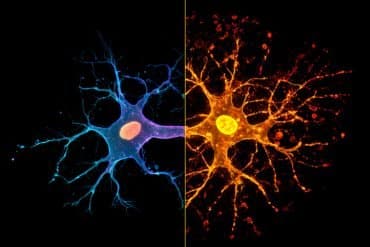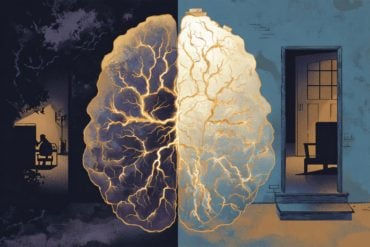Summary: Training elementary school students in creativity has shown potential in amplifying their resilience against real-world challenges.
Researchers equipped third to fifth-graders with literary techniques to enhance creativity when addressing problems. These creative methods, including perspective shifting and causal thinking, were found to significantly aid students in devising innovative solutions.
Such training equips children with a robust arsenal to tackle adversities, particularly in the challenging aftermath of events like COVID-19.
Key Facts:
- The study demonstrated that students trained in perspective-shifting could successfully devise solutions to 94% of age-typical and personal problems.
- A five-day narrative creativity curriculum further solidified these findings, with every participating student providing a second solution when their initial one was challenged.
- This creative training underscored the vital role of narrative techniques, suggesting that exposure to arts, literature, and theater, when approached correctly, can be instrumental in fostering real-world problem-solving abilities.
Source: Ohio State University
Train elementary school students how to be creative and you can help increase their resilience in the face of real-life problems, new research suggests.
In a small study, researchers trained third, fourth and fifth graders to use literary techniques such as perspective shifting, counter-factual (what if) thinking and causal (why) thinking to improve creativity in dealing with difficulties.
The techniques helped kids come up with new, creative and practical ways to solve problems, said Angus Fletcher, lead author of the study and a professor of English at The Ohio State University and member of the university’s Project Narrative.

“There are concerns about the resiliency of American children in the wake of COVID-19 and this sense that many kids are having a hard time in school and in life,” Fletcher said.
“Creativity training can help kids come up with a second plan when things aren’t working out for them.”
The study was published recently in the Journal of Creativity.
Fletcher said the program used to help kids in this study was similar to one he and his colleagues used successfully with the U.S. Army – and which resulted in Fletcher receiving the Public Service Commendation Medal, the fourth-highest public service decoration that the Army can bestow upon a civilian.
The researchers did two separate studies involving students attending a summer camp in a Columbus suburb.
In one study, 32 students were split into two groups. In the control condition, the children were told to identify a special quality about themselves. They were told this was their special power that could help them solve any problem.
In the creative condition, the students were told to think of a friend who did something special and think of them as their “creative friend” who could help them solve any problem. This type of creativity training is called perspective-shifting, in which the kids look at a problem through the eyes of someone else.
“When you ask people to shift their perspective and imagine receiving advice from a friend, you get a lot more creative and effective solutions to problems than just trying to solve the problem yourself,” Fletcher said.
And that’s what the study found. In one part of the study, teachers identified a problem that was challenging for their students – for example, not being able to go to a friend’s birthday party because you’re going to be out of town with your parents.
Students also thought about a challenging problem in their own lives. Some problems that were mentioned included “my brother has a communication disorder,” “my dad has to be away for two months” and “my sister bullies me.”
Results showed that without the perspective-shift training, fewer than half of the students were able to provide a solution to the age-typical problems and almost none were able to provide a solution to their own problems.
But 94% of those who were trained in perspective-shifting provided a solution to both.
Judges (who were trained teachers) also rated the children’s solutions on creativity, as assessed by how surprising or unique the solutions were.
With the intervention, the average creativity score was 6.44 out of 10 (moderate creativity) compared to 3.05 (low creativity) for those who did not receive the perspective-shifting intervention.
These results showed how creativity training could boost children’s sense of self-efficacy – the belief that they had some control and power over their own lives, Fletcher said.
When considering their own problems, most of the children who received the intervention came up with a potential solution. But 15 of 16 children in the control group essentially gave up, Fletcher said. They either said they didn’t know how to fix their problem, or displayed some version of magical thinking, such as saying they could become a superhero.
A second longitudinal study involving 28 students in the same camp was designed to test the effects of a five-day, 10-hour narrative creativity curriculum on creativity, self-efficacy and resilience.
In addition to perspective-shifting, the students were also trained in other narrative creativity techniques, such as causal thinking, Fletcher said.
“If children can’t solve a problem, we train them to back up and think about what they are trying to accomplish – the why problem,” Fletcher said.
“Step back and say why does this matter? We often find that if you think more broadly about what you are trying to accomplish, and why it is so important, then you can see there are other ways of getting what you want.”
At the end of the curriculum, the students were presented with age-typical problems similar to the first study and also examined one of their own problems.
In order to test resilience, the researchers provided an unexpected challenge when the children presented their proposed solution to their problems: they told the kids it wouldn’t work.
Results showed that every student who took the five-day curriculum was able to provide a second solution to both the age-typical and personal problems.
“With this training, the children were unfazed by being told their first solution didn’t work. They came up with a second plan, which is a good test of resilience,” Fletcher said.
And the second solution to the problems averaged higher creativity scores from the judges – 7.5, which indicated moderate to high creativity, compared to 5.45 for their first solution.
Second solutions also scored higher on utility, which is how likely they are to succeed in the real world.
Fletcher said this study provides a hopeful message: There are things we can do to help children cope with their problems.
“We are at this moment in our society where our kids need help. We found that before this training, kids had this propensity to just give up when faced with problems. That could lead them to get angry, or embarrassed that they can’t solve their problems, or look for adults to offer solutions.”
What narrative creativity training can do is teach children there are ways to approach real-life problems that don’t have easy answers, he said.
Fletcher said that kids can learn creativity through the arts, such as literature and theater, if they are done the right way. Rather than just asking students to analyze works of art, teachers can have students imagine themselves as different characters, explore new perspectives and engage in why and what-if thinking.
“The ability to use this type of thinking can’t be assessed via standardized tests. But it is still very important and can help children use and grow their creativity to solve real-world challenges,” he said.
Fletcher conducted the study with Ohio State colleagues Patricia Enciso, a professor of literature for children and young adults in the College of Education and Human Ecology, and Mike Benveniste, also of Project Narrative.
About this psychology and creativity research news
Author: Jeff Grabmeier
Source: Ohio State University
Contact: Jeff Grabmeier – Ohio State University
Image: The image is credited to Neuroscience News
Original Research: Open access.
“Narrative creativity training: A new method for increasing resilience in elementary students” by Angus Fletcher et al. Journal of Creativity
Abstract
Narrative creativity training: A new method for increasing resilience in elementary students
Narrative creativity training has recently shown promise as a tool for increasing self-efficacy and resilience in adult learners.
The training employs dramatic and literary techniques such as perspective-shifting, counterfactual (i.e., what-if) thinking, and causal (i.e., why) thinking to improve real-world problem solving.
To explore whether narrative creativity training could have similar benefits for younger populations, this study piloted a test on elementary students.
A five-minute randomized controlled trial conducted with 32 third, fourth, and fifth grade students yielded increased self-efficacy and creative problem-solving, and a five-day longitudinal trial conducted with 28 students from the same population was associated with increased resilience.
The results suggest the potential practical benefits of incorporating theater, literature, comics, and other story-based art into elementary school curricula.







